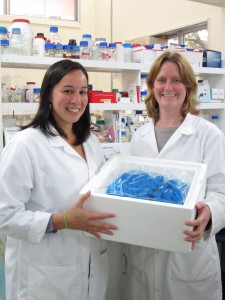The Global Rumen Census project receives its first samples
AgResearch scientists Gemma Henderson and Peter Janssen are conducting a census of rumen microbes from farmed ruminants in different parts of the world. This is being done as part of a Livestock Research Group project funded by New Zealand’s Ministry for Primary Industries (formerly Ministry of Agriculture and Forestry), as part of its commitment to the Global Research Alliance on Agricultural Greenhouse Gases (GRA).

Faith Cox and Dr Gemma Henderson with the package containing rumen samples from Canada, the first to arrive for the global census of rumen microbes
Ruminants have a modified digestive tract, in which the feed is first fermented by a complex community of microbes in a forestomach called the rumen. This has the advantage of converting feed that is of low energy value for mammals into products that are more valuable for the ruminant animal. However, one of the by-products of this fermentation is methane, which is released into the atmosphere.
This ruminant derived methane is implicated in global climate change. In response to this, research groups around the world are working to develop mitigation technologies to reduce the amounts of anthropogenic greenhouse gases produced from animal agriculture. Among these are technologies to inhibit the methane producing microbes or to direct the rumen fermentation away from methane and towards products that benefit the animal.
Modifying the rumen fermentation required a good knowledge of which microbes are to be targeted. If all ruminants harbour essentially the same microbes, then mitigation technologies targeting microbes are likely to be universal and transferable. This is where Gemma and Peter and their research come in. They are conducting a census of rumen microbes in samples being sent to them from a network of collaborators and colleagues from around the world. At the time of writing, samples have arrived or have been promised from Argentina, Australia, Brazil, Canada, Chile, Ethiopia, France, Ireland, Japan, Kenya, Korea, Mexico, Netherlands, New Zealand, Slovenia, United Kingdom, United States and Uruguay. Some countries are represented by multiple research institutes, which adds valuable diversity to the range of animals and feeding systems.
Any researchers who are interested in participating in this project and are able to supply samples can contact the project team at [email protected].
By Peter H. Janssen
